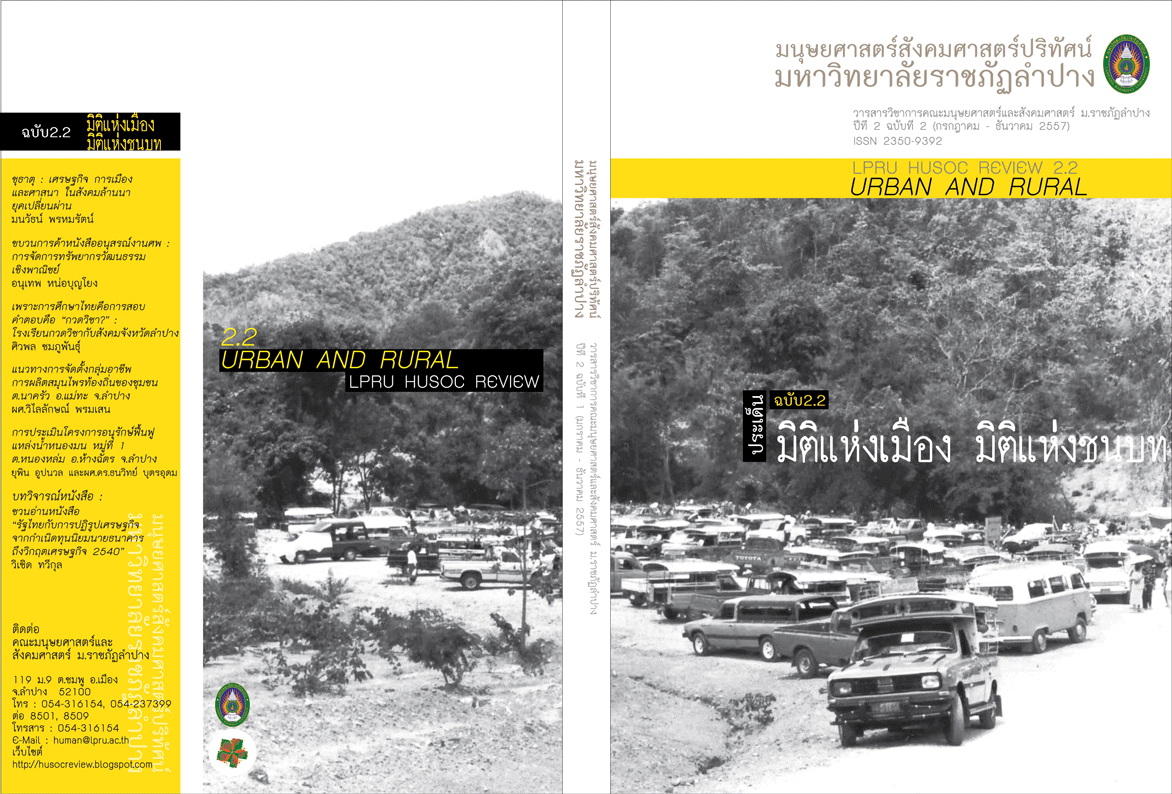แนวทางการจัดตั้งกลุ่มอาชีพ การผลิตสมุนไพรท้องถิ่นของชุมชน ตำบลนาครัว อำเภอแม่ทะ จังหวัดลำปาง / Guidelines for Forming a Local Herb Production Community Occupational Group in Tambon Na Krua of Mae Tha District, Lampang
บทคัดย่อ
แนวทางการจัดตั้งกลุ่มอาชีพการผลิตสมุนไพรท้องถิ่นของชุมชนในเขตพื้นที่ตำบลนาครัว อำเภอแม่ทะ จังหวัดลำปาง มีวัตถุประสงค์ใน
การศึกษา เพื่อสำรวจความคิดเห็นของประชาชน และหาแนวทางจัดตั้ง
กลุ่มอาชีพแปรรูปสมุนไพรจากท้องถิ่นเพื่อรองรับตลาดสมุนไพรในอนาคต
ลักษณะงานวิจัยเป็นการวิจัยเชิงสำรวจ (Survey Research) กลุ่มตัวอย่า
งที่ใช้ในการดำเนินการวิจัย จำนวน 129 คนโดยใช้วิธีการสุ่มแบบเจาะจง
การวิเคราะห์ข้อมูลใช้โปรแกรมคอมพิวเตอร์สำเร็จรูปวิเคราะห์ข้อมูลโดย
แจกแจงเป็นค่าร้อยละพร้อมบรรยายใต้ตาราง
ผลการวิจัย พบว่า ในชุมชนมีสมุนไพรที่นิยมใช้เป็นทั้งอาหารและ
ยา รวมถึงการใช้ในพิธีกรรมที่เกี่ยวข้องกับการดำรงชีวิตของคนในชุมชน
รวมทั้งหมด 51 ชนิด ในแต่ละชนิดพบว่า มีปริมาณที่พบอยู่ในชุมชนมาก
ถึง 48 ชนิด และมีอยู่ในระดับปานกลาง และน้อย จำนวน 3 ชนิดที่ต้อง
รีบดำเนินการอนุรักษ์และฟื้นฟู ในส่วนของข้อมูลเกี่ยวกับปราชญ์ชาว
บ้าน ผู้รู้ หรือหมอเมือง ที่มีความรู้ความสามารถด้านการรักษาโรคด้วย
สมุนไพรมีจำนวนทั้งหมด 9 คน มีอายุเฉลี่ยประมาณ 69 ปีมีความชำนาญ
การรักษาโรคด้วยสมุนไพร คือ เป็นหมอเป่าเสก จำนวน 7 คน
หมอปรุงยา จำนวน 1 คน หมอตำแย จำนวน 1 คน และหมอต่อกระดูก
จำนวน 1 คน มีวิธีการสืบสานและต่อยอดภูมิปัญญามาจากครอบครัว
ผลการศึกษาความพร้อมของชุมชนในการจัดตั้งกลุ่มอาชีพการ
แปรรูปจากสมุนไพร พบว่า ประชาชนมีความพร้อมอยู่ในระดับสูง คิดเป็น
ร้อยละ 71.70 และพร้อมที่จะร่วมลงทุนในลักษณะหุ้นส่วนคิดเป็นร้อยละ
67.50 โดยมีเหตุผลในการเข้าร่วมเป็นสมาชิกกลุ่มเพราะอยากมีอาชีพและ
รายได้เสริม คิดเป็นร้อยละ 35.83
สำหรับแนวทางการส่งเสริมการจัดตั้งกลุ่มควรมีการส่งเสริมให้
กลุ่มดำเนินการใน 3 ประเด็นก่อนการจัดตั้งกลุ่ม คือ (1) การสำรวจความ
ต้องการการใช้สมุนไพรของท้องตลาด เพื่อนำมาวางแผนพัฒนาการดำเนิน
งานของกลุ่ม (2) ควรมีการจัดฝึกอบรมเชิงปฏิบัติการเกี่ยวกับมาตรฐาน
การผลิตสมุนไพรให้แก่สมาชิกกลุ่มเพื่อเป็นการประกันคุณภาพ และมาตร-
ฐานในการพัฒนาผลิตภัณฑ์จากสมุนไพรของกลุ่ม และ (3) ควรมีบุคลากร
ทางการแพทย์แผนปัจจุบันเข้ามาเป็นที่ปรึกษาให้คำแนะนำที่ถูกต้องตาม
เกณฑ์มาตรฐานของการผลิตผลิตภัณฑ์จากสมุนไพร
คำสำคัญ สมุนไพรท้องถิ่น กลุ่มอาชีพเสริม
*บทความนี้เป็นส่วนหนึ่งของงานวิจัย วิไลลักษณ์ พรมเสน. การศึกษาความเป็นไปได้ในการจัดตั้งกลุ่ม
อาชีพ การผลิตสมุนไพรท้องถิ่นของชุมชนในเขตพื้นที่ตำบลนาครัว อำเภอแม่ทะ จังหวัดลำปาง ทุน
วิจัยของคณะมนุษยศาสตร์และสังคมศาสตร์ มหาวิทยาลัยราชภัฏลำปาง พ.ศ. 2555
The objectives of this study were to survey the opinion of the local people and to explore suitable guidelines for forming a local herb production community
occupational group to support the future herb market.
This survey research includes 129 samples which were
selected by purposive sampling method. Collected data
were then analyzed by a computer program and statistically disseminated by percentage with explanations.
The result showed that there are 51 different herbs
in this community, that are used both as foods and
medicines as well as being parts of traditional rites
relating to the local life of the people. In terms of quantity,
there are 48 kinds of herbs in the community that can be
found in high amount level while 3 kinds can be found
in moderate and low amount levels. Thus, these 3 kinds
less found should be conserved and restored instantly.
Regarding the data about local scholars or local traditional
healers or “mor muang” in Thai language who have
knowledge and skills on traditional medicine using local
herbs, there are 9 mor muangs in this community. The
average age of these mor muangs is about 69 years old.
Regarding their treatment skills, 7 of them are blowing
healers (blowing with holy water and magic spell), 1 person
is a medicine compounding healer, 1 person is a midwife and
1 person is a bone healer. Most of them have learned and
inherited the local wisdom knowledge from their families.
The result, from studying the readiness of the community
for forming a local herb production occupational group,
showed that the level of people’s readiness is high with
percentage of 71.70. The readiness level for joining the
investment as a partner is at 67.50 percent. In terms
of reasons for joining as a member of the group, the
highest percentage is 35.83 percent which is the reason
that they want to have a job and gain additional incomes.
Regarding the guidelines for forming the occupational group,
there are 3 issues should be encouraged to administer
before forming the group which are; 1) conducting a market
survey to check the demand of using herbal medicines in
order to use the survey result for planning the work, 2)
organizing a workshop training for the group members on the
standard of herbal medicine production as part of the quality
assurance and standardization process for the herbal
products of the group, and 3) having a medical doctor as
a consultant who can give suggestions and
recommendations according to the standard protocol for
herbal products production.
Key Words: Local Herb, Occupational Group
ดาวน์โหลด
เผยแพร่แล้ว
2016-03-26
ฉบับ
ประเภทบทความ
บทความวิจัย (Research article)



